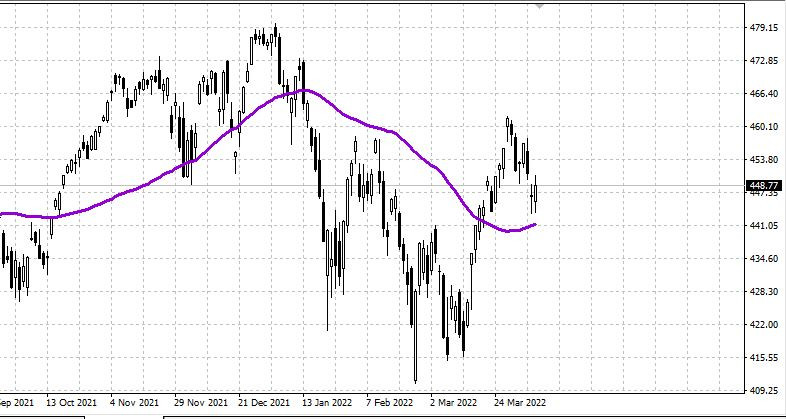

S&P500
The tension in the global markets has slightly subsided. The Kremlin has softened its stance.
On Thursday, the US market rose for the first time after the Fed's negative comments.
The major US indices gained yesterday: the Dow Jones went up 0.3%, the NASDAQ added 0.1%, the S&P500 increased by 0.4%.
Yesterday, the Russian ruble strengthened significantly again. On Friday morning, the dollar and the euro are trading at 75 and 81 respectively on the MICEX exchange. Notably, the ruble has been strengthened artificially caused by serious problems for importers due to the Western sanctions imposed against Russia last month. At the same time, another reason for its dramatical strengthening is the Central Bank of Russia's demand for exporters to sell 80% of foreign exchange earnings. Russia is expected to default on its international debt around May 4 as the Kremlin has decided to make debt payments in rubles. It is evident that Russia would repay the entire international debt if the US and the UK did not freeze the Kremlin's substantial funds in the West. The UK announced that it had frozen $350,000 of Russian assets recently. However, these are specific issues in terms of commercial law. Moreover, there were fundamental reasons for imposing sanctions on Russia.
The S&P500 is trading at 4,500. It remains in the range of 4,470 - 4,540
Energy: Oil is under pressure after the US decision to release oil from its strategic reserves. Yesterday, the IEA confirmed that the US and its partners planned to sell 240 million barrels of oil from its reserves during a year. On Friday, Brent crude oil is trading at $101.
The Fed said this week that it would begin to reduce its balance sheet at a rate of $95 billion a month. It is considered a significant tightening of monetary policy that could completely inhibit the growth of the US market in the long term.
The US labor market is strong: Jobless claims fell to 166,000, a decrease below 200,000 during the week. The number of people receiving ongoing unemployment assistance is holding steady around 1.5 million. It rose to 1.523 million yesterday.
The USDX is trading at 99.80 and is expected to be in the range of 99.50 - 98.10. The dollar is gradually strengthening on the Fed's tightening policy.
The USDCAD is trading at 1.2580, the range is 1.2500 - 1.2700. The pair has reversed sharply upwards. The downward movement was halted as oil prices fell and the dollar is strengthening.
Conclusion:
Paradoxically, global stock markets have calmed down. Tensions have eased despite the Russia-Ukraine conflict entering its final stage. Further details are below.
Yesterday, The United Nations General Assembly suspended Russia from its seat on the Human Rights Council. 98 of 175 countries voted in favor of this decision. This is a trial solution. If the Kremlin does not end hostilities in Ukraine, Russia can be removed from the UN Security Council. Although, it is complicated and unlikely. However, the USSR experienced similar difficulties in 1940.
The US and the EU are tightening sanctions against Russia. However, the EU has failed to ban Russian oil and gas imports so far.
The US and EU countries have agreed to supply heavy weapons to Kyiv.
Russia-Ukraine conflict. The Kremlin needs at least to achieve a local convincing victory to: a) strengthen its position in peace talks with Kyiv; b) to announce the victory to its citizens on TV. Currently, Russian troops are advancing on the eastern Ukraine with these goals. Therefore, the coming weeks before May will be decisive.
As indicated above, the Kremlin has softened its stance. Kremlin spokesman Peskov gave an interview yesterday. He mentioned that the Russian military had suffered heavy losses. Moreover, the Russian Defense Ministry has not released any figures for a long time. Peskov noted that Russia would possibly not reach the goals of its military operation and the Russia-Ukraine conflict could be resolved. These are positive signals for global stock markets. Moscow will likely start a constructive dialogue with Ukraine at next peace talks.